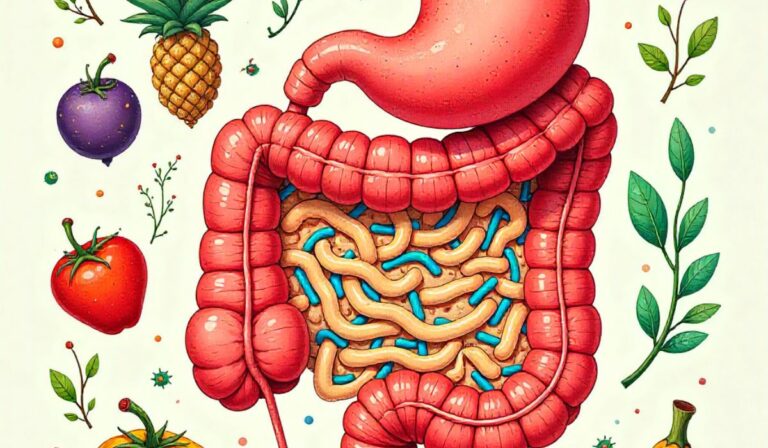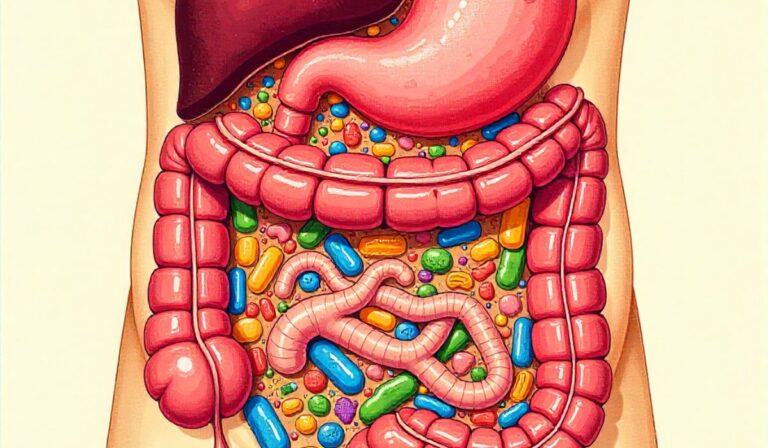Cycling Probiotics vs Continuous Use: Weighing Benefits and Drawbacks
Ever feel a rumble in your tummy and wonder if it’s your gut talking? Maybe you’ve considered taking probiotics to help keep things running smoothly.
Deciding whether to use them continuously or in cycles, like a workout routine, is a common question.
This article breaks down the good and bad of both methods. You’ll learn the best approach for you, improving your gut health knowledge and helping you make informed decisions.
We’ll explore the science and give you practical advice, helping to keep you from endlessly searching the internet!
Key Takeaways
![Cycling Probiotics vs Continuous Use Weighing Benefits and Drawbacks[1]](https://mycleanseplan.com/wp-content/uploads/2025/10/Cycling_Probiotics_vs_Continuous_Use__Weighing_Benefits_and_Drawbacks1.jpg)
Exploring Probiotics: The Gut’s Friendly Helpers
The gut is a bustling city, home to trillions of bacteria – some helpful, some harmful. These bacteria, collectively called the gut microbiome, play a huge part in digestion, immunity, and even mood.
Probiotics are live microorganisms, mainly bacteria, that, when consumed, provide health benefits.
Think of them as reinforcements for your gut’s friendly forces. They help restore balance, support digestion, and potentially boost your overall well-being. Understanding their role is the first step in deciding how to use them.
What are Probiotics?
Probiotics are live microorganisms that, when ingested in adequate amounts, confer a health benefit on the host.
These are usually bacteria, but can also be certain types of yeast. The most common probiotic bacteria come from the Lactobacillus and Bifidobacterium genera. Different strains within these genera have unique properties and benefits.
They work by competing with harmful bacteria, aiding in digestion, producing vitamins, and supporting the immune system.
The effectiveness of a probiotic depends on several factors, including the strain, the dosage, and the individual’s gut environment. A good analogy is planting a garden: the type of seed (strain) and the soil conditions (gut environment) both matter.
- Different Strains: Not all probiotics are created equal. Different strains offer different benefits. For example, some strains are better for digestive issues, while others may support immunity. The strain name (like Lactobacillus acidophilus) is important; it tells you exactly what kind of bacteria you’re getting.
- Dosage Matters: The number of live organisms in a probiotic, measured in colony-forming units (CFUs), impacts its effectiveness. A higher CFU count doesn’t always mean a better probiotic, but it often indicates a stronger concentration. The ideal dosage depends on the strain and the reason for taking the probiotic.
- Delivery Methods: Probiotics come in various forms, including capsules, powders, yogurts, and fermented foods. The delivery method can affect how well the probiotics survive the journey through the stomach to reach the gut. Capsules are designed to withstand stomach acid, while foods like yogurt naturally contain probiotics.
- Prebiotics: While probiotics are the live bacteria, prebiotics are the food that feed those bacteria. Fiber-rich foods and supplements containing prebiotics can boost the effectiveness of probiotics by creating a thriving environment for them in the gut.
The Gut Microbiome: Your Inner Ecosystem
The gut microbiome is the collection of trillions of microorganisms living in your digestive tract. It’s a complex ecosystem, more like a rainforest than a desert.
This community includes bacteria, fungi, viruses, and other microbes. It plays a vital role in your health. A balanced microbiome supports digestion, helps you absorb nutrients, strengthens your immune system, and even influences your mood.
Things like diet, stress, and medications can disrupt this balance, leading to various health issues. Keeping this ecosystem healthy is key, and probiotics can be one tool to help.
- Diversity is Key: A diverse gut microbiome is generally considered a healthy one. The more different types of microorganisms you have, the better. This diversity helps the gut adapt to changes and perform its many functions. A poor diet can reduce the diversity of your gut.
- Impact on Digestion: The gut microbiome breaks down food that your body can’t digest on its own. It ferments fiber, producing short-chain fatty acids (SCFAs) that nourish the cells lining your gut. SCFAs also have anti-inflammatory effects and support overall gut health.
- Immune System Connection: About 70-80% of your immune cells reside in your gut. The gut microbiome communicates with the immune system, training it to distinguish between friend and foe. A healthy microbiome can reduce inflammation and make you more resistant to infections.
- Mental Health Link: There is a growing body of evidence showing a link between gut health and mental well-being. The gut and the brain communicate through the gut-brain axis. Imbalances in the gut microbiome may affect mood, anxiety, and even cognitive function.
Continuous Probiotic Use: Daily Support or a Long-Term Commitment?
Choosing to take probiotics every day is like having a constant team of helpers in your gut. This approach can be a good choice if you struggle with chronic digestive issues or need consistent support for your immune system. However, it’s not the only way to go.
There are things to consider to know if daily usage is right for you. It's like deciding if you want a reliable everyday car or a seasonal vehicle.
Potential Benefits of Continuous Use
Taking probiotics consistently can lead to several potential benefits, especially for those experiencing persistent digestive problems or needing ongoing support for their overall health. Continuous use can help reinforce and maintain a healthy gut microbiome.
Like watering a plant every day, providing a steady supply of probiotics helps ensure the gut remains balanced. This steady support can lead to significant improvements.
- Improved Digestion: Daily intake can help regulate bowel movements, reduce bloating and gas, and make digestion more efficient. For individuals with conditions like irritable bowel syndrome (IBS), ongoing probiotic use can provide lasting relief from symptoms.
- Enhanced Immune Function: Consistent probiotic use may strengthen your immune system, making you less susceptible to infections. They help regulate the immune response, reducing inflammation and supporting overall immune health. This can be particularly beneficial during cold and flu season.
- Reduced Inflammation: Certain probiotic strains have anti-inflammatory properties, which can help reduce chronic inflammation throughout the body. Chronic inflammation is linked to various health issues, so the anti-inflammatory effects of probiotics can contribute to overall wellness.
- Consistent Support for Gut Health: Regular intake can help maintain a balanced gut microbiome, which is essential for overall health. This approach can be especially valuable for individuals with compromised gut health due to lifestyle factors, diet, or medications.
Potential Drawbacks of Continuous Use
While taking probiotics daily can offer benefits, there are also potential drawbacks to consider. Continuous use may lead to some unexpected issues, such as a shift in your gut’s natural balance.
It is like using a fertilizer on your lawn – too much can have the opposite effect. Understanding these potential downsides is crucial for making informed decisions about your probiotic usage.
- Dependency and Reduced Natural Production: The gut might become reliant on external probiotics, potentially reducing the body’s natural ability to produce these beneficial bacteria. The gut may become less active on its own.
- Possible Side Effects: Some people experience mild side effects like bloating, gas, or changes in bowel movements when starting or continuing probiotics. These symptoms usually subside, but they can be uncomfortable.
- Strain Specificity: Not every probiotic is right for everyone. Using the wrong strain for a long period might not provide the intended benefits and could even lead to imbalances in the gut.
- Cost: Taking probiotics daily can be an ongoing expense. While the long-term cost may be worth the benefits for some, it is still something to consider.
Cycling Probiotics: A Strategic Approach
Cycling probiotics involves taking them for a specific period, then taking a break before starting again. It’s like a fitness routine, with periods of active use followed by recovery.
This approach aims to address the potential drawbacks of continuous use. You may be able to support a healthy gut microbiome while also allowing your body to function naturally. It requires some planning, but can be a powerful method.
How to Cycle Probiotics
Cycling probiotics typically involves taking them for a set time (e.g., 1-3 months), followed by a break (e.g., 1-2 months) before resuming.
The cycles can vary depending on individual needs and the advice of a healthcare professional. Cycling helps to avoid the potential issues associated with continuous use and allows the gut microbiome to adapt and respond naturally. It’s like switching between different exercises in a workout routine.
- Determine the Cycle Length: There’s no one-size-fits-all answer for how long you should take probiotics. A common approach is to take them for 1-3 months, followed by a break of 1-2 months. The duration depends on your personal health goals and response to the probiotics.
- Choose the Right Strains: When cycling probiotics, selecting the appropriate strains is important. Consider your health needs and the specific benefits offered by each strain. It is a good idea to rotate between different strains to ensure a more varied approach.
- Monitor Your Body: Pay attention to how your body responds during both the active periods and the breaks. This can help you figure out what cycle length works best for you and if specific strains are benefiting you. Note any changes in digestion, energy levels, or other symptoms.
- Consider Prebiotics: Include prebiotic-rich foods or supplements, especially during the breaks. Prebiotics feed the good bacteria in your gut. They boost the effectiveness of the probiotics and help maintain a healthy microbiome during the periods when you are not taking probiotics.
Advantages of Cycling
Cycling probiotics offers several potential advantages. This method can help avoid dependency and allow the gut to work naturally. It can be like giving your body a reset and ensuring continued effectiveness. It is a flexible strategy that many individuals can appreciate.
- Avoid Dependency: Cycling can reduce the risk of your gut becoming reliant on external probiotics. This allows your body to maintain its natural ability to produce and regulate gut bacteria. This can maintain your gut balance in the long run.
- Prevent Imbalance: Rotating strains or taking breaks helps to avoid a specific type of bacteria dominating your gut. Cycling can support a diverse and balanced microbiome, contributing to overall health.
- Monitor Effectiveness: Cycling allows you to better assess the impact of probiotics on your health. You can observe the difference during the active periods and the breaks. This feedback helps you fine-tune your approach over time.
- Reduce Side Effects: Cycling may help minimize the risk of experiencing side effects associated with continuous use. Taking breaks allows your body to adapt.
Disadvantages of Cycling
While cycling probiotics has benefits, there are also potential drawbacks. Cycling requires more planning and attention than continuous use.
It may not be the best method for those with specific health conditions that require ongoing gut support. Considering these aspects ensures you are making the best choice for your health.
- Requires Planning: Cycling requires a more structured approach and can be harder than simply taking a probiotic daily. You need to remember when to start and stop, and you need to keep track of your progress.
- Potential for Gaps in Support: During the breaks, you might experience a temporary decrease in the benefits if your gut needs constant support. This is more of a factor for individuals with ongoing digestive issues.
- Difficulty Finding the Right Cycle: It can take time and experimentation to find the optimal cycle length and probiotic strains. The process requires being patient and paying attention to your body.
- Inconsistency: If you forget to start or stop your probiotic routine, you might not get the full benefits.
Choosing the Right Probiotic Strategy for You
Deciding between continuous use and cycling probiotics depends on your individual needs, health goals, and overall lifestyle.
There is no universally “best” approach; the optimal strategy varies from person to person. Consider your health history, symptoms, and the advice of your healthcare provider when making your decision. It is like picking the right tool for the job. Consider these factors to find the ideal approach for you.
Assessing Your Health Needs
Your health needs are the main factor in deciding how to use probiotics. Those with specific health problems may benefit from either continuous or cyclical use. Consider your digestive health, immune function, and any existing medical conditions. Your health history and current state will guide your decision-making.
- Digestive Issues: If you struggle with chronic digestive problems like IBS or frequent bloating, continuous use may be beneficial. The consistent support from probiotics can provide sustained relief. Alternatively, cycling could be used to see if you can achieve similar results without constant supplementation.
- Immune Support: If you have a weak immune system or frequently get sick, continuous use can help boost your body’s defenses. It is particularly helpful during the cold and flu season.
- Antibiotic Use: If you’re taking antibiotics, probiotics can help replenish beneficial bacteria in your gut. In this situation, taking probiotics throughout the course of antibiotics and for a few weeks afterward may be beneficial.
- General Wellness: For overall health and well-being, both continuous use and cycling can be effective. Consider cycling to avoid dependency and to support the natural balance of your gut.
Consulting With a Healthcare Professional
It’s always a good idea to consult with a healthcare professional before starting any new supplement regimen, including probiotics. They can provide personalized advice based on your individual health needs.
They can help you figure out the best approach. Consulting with a professional can help you choose the right product and prevent any potential problems.
- Get Personalized Advice: A healthcare provider can assess your health and advise you on the best probiotic strains and dosages. They will consider your existing medications and health history.
- Discuss Potential Interactions: They can tell you about any potential interactions between probiotics and other medications you are taking. This is important to ensure your safety.
- Monitor Progress: A healthcare provider can help you monitor your progress and make adjustments to your probiotic strategy. This ensures that you are getting the best possible results.
- Address Underlying Issues: They can help identify any underlying health conditions that might be contributing to your symptoms. They can also offer guidance on lifestyle changes that could improve your gut health.
Experimentation and Observation
The best probiotic strategy might involve some trial and error. You’ll need to listen to your body and adjust your approach accordingly.
Keeping a journal can help you track your progress. Over time, you can determine the best approach for you.
- Start with a Baseline: Before starting any probiotic regimen, keep track of your current digestive symptoms, energy levels, and overall well-being. This will allow you to assess the impact of the probiotics.
- Try Continuous Use: If you decide to start with continuous use, monitor your body’s response. Note any changes in your digestive symptoms, immune function, and overall health. If you experience negative side effects, consult with a healthcare professional.
- Try Cycling: If you choose cycling, follow a structured approach. Take the probiotics for a set period, then take a break. Record how your body feels during both phases.
- Adjust Based on Feedback: Use your observations to adjust your approach. If you feel better on continuous use, continue with that method. If cycling works better, refine your cycles and probiotic strains.
Here is a comparison chart to help clarify the main differences between continuous and cycling probiotic usage:
| Feature | Continuous Use | Cycling Use |
|---|---|---|
| Mechanism | Constant supply of probiotics to support gut health. | Alternating periods of probiotic use and breaks. |
| Typical Duration | Daily, long-term. | Periods of 1-3 months with breaks of 1-2 months. |
| Potential Benefits | Consistent support for digestion and immune function. | Reduces dependency, supports natural gut function, can avoid side effects. |
| Potential Drawbacks | Dependency, side effects, can reduce the natural production of probiotics by the body. | Requires more planning, potential gaps in support during breaks. |
| Best For | Those with chronic digestive issues or ongoing immune concerns. | Individuals seeking to maintain gut health, manage symptoms, or avoid continuous use. |
FAQ Of Cycling Probiotics vs Continuous Use
What’s the difference between prebiotics and probiotics?
A: Probiotics are the live bacteria that you ingest, while prebiotics are the food that feed those bacteria. Prebiotics support the growth and activity of the probiotics in your gut. They work together to maintain a healthy gut microbiome.
Can you take too many probiotics?
A: It’s generally safe to take probiotics, but excessive amounts can sometimes lead to side effects like bloating or gas. Always follow the recommended dosage and consult with a healthcare professional if you’re experiencing any issues.
Are all probiotic strains equally effective?
A: No, different strains of probiotics have different benefits. Some strains are better for digestive issues, while others support immunity. When selecting a probiotic, consider the specific strains and their intended purpose.
Do probiotics need to be refrigerated?
A: Some probiotics need to be refrigerated to maintain their potency, while others can be stored at room temperature. Check the product label for storage instructions to ensure the probiotics remain viable.
When is the best time to take probiotics?
A: The best time to take probiotics is often with a meal. This can help the probiotics survive the stomach acid and reach your gut. If you have any questions, consult your healthcare provider for the best time to take them.
Final Thoughts
Deciding between cycling probiotics and continuous use is a personal choice. Consider both the potential advantages and disadvantages to discover which strategy fits your needs.
Continuous use provides consistent support, while cycling might prevent dependency and keep your gut working naturally. You can experiment, listen to your body, and get advice from a professional.
The journey to better gut health is unique to you. So be patient, stay curious, and enjoy the process of discovering what works best for your well-being!

![Microbial Signature Index Unveiling Disease Prediction Capabilities[1]](https://mycleanseplan.com/wp-content/uploads/2025/10/Microbial_Signature_Index__Unveiling_Disease_Prediction_Capabilities1-768x448.jpg)
![Detox Drinks & Gut Flushes Separating Fact from Fiction[1]](https://mycleanseplan.com/wp-content/uploads/2025/11/Detox_Drinks__Gut_Flushes__Separating_Fact_from_Fiction1-768x448.jpg)

![Decoding the Gut AI and LLMs' Role in Microbiome Research[1]](https://mycleanseplan.com/wp-content/uploads/2025/10/Decoding_the_Gut__AI_and_LLMs_Role_in_Microbiome_Research1-768x448.jpg)

